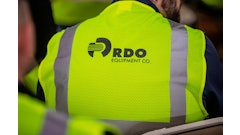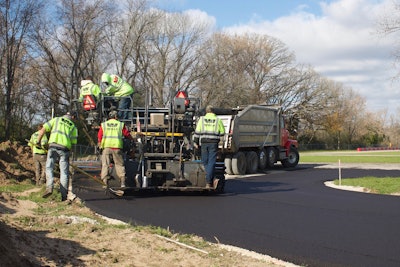
Sometimes history repeats itself. Such is the case when Wolf Paving Company, Oconomowoc, WI, chose to participate in expanding and reconstructing a raceway their grandfather had built 60 years earlier.
“In the early, early days we (Lowell Wolf, second generation Wolf Paving owner) and I started racing Go-Karts around a drive way,” says Leeland Wolf. “We paid an off duty cop to stop the traffic when the karts came by. We purchased six karts and became a dealer for the state of Wisconsin.”
Soon, the sport was gaining popularity with Leeland holding races regularly, but the county police began to worry about races every night and on weekends so he began looking for a better spot to race.
“Emery Owens on the west of Dousman had an onion farm with the high ground just sitting there,” he says. “I purchased the front 40 acres for $100 down and $500 a year until $15,000 was paid.”
Leeland and Lowell Wolf graded a small kidney shape track and paved it with their own original Barbara Greene paver.
“We then had races every weekend. Participation was forty to fifty karts a weekend and so I started the North American Karting Association (NAKA),” Leeland says. “We started rules, sizes and some sort of organization and the excitement grew. Each weekend there were more karts and our sales grew as we took on Rupp Karts, UMP Karts and Fox Karts as dealers. We went to dual engines and triple engines.”
The two decided it was time to make the raceway a true road course track. Lowell and Leeland graded the track, hauled all the gravel in every night and during any spare time. They then hired local contractor Payne and Dolan to pave the track for them.
Track expansion planned, re-planned & planned again
Fast forward 60 years and the Badger Kart Club now operates the raceway, hosting a variety of local, regional and national karting events annually. With racing being held most Sundays, April through October and free weekly spectator races thrown in there, now was the right time for the track to be upgraded.
The job at Badger Kart Club was to start after the racing season was finished at the end of August/beginning of September 2016.
Tim Hansen, project manager at Wolf Paving and Brian Gallick, the estimator for the job, went to the racetrack, walked the open grass/tree lined area and put stakes in the ground showing the new track layout.
“Brian had a plan in which he scaled the distance from the existing track so we could use a 300 ft. tape measure and get the layout close,” Hansen says. “Once the layout was complete, the track committee had volunteers come to cut down the brush/trees and remove some stumps in the area.”
Wolf Paving then brought in a Caterpillar D8 Dozer to level off the ground in the new track area and push some of the stumps that were left over into a pile on the edge of the property.
After that was done, Wolf Paving staked the boundary areas again.
“The track committee came out and walked the site based on our staking,” Hansen says. “They made some changes to the length on a straight away and wanted some other radiuses widened out.”
They brought in an excavator to dig in the new track roadway area and left the dirt/sand material on site for backfill. Wolf created a firm sub-base to support the structure of the asphalt surface. For this project, 12-in. of crushed concrete was used.
“We had to build a temporary stone pad to the site so we could keep the equipment off of the existing track,” Hansen says. “Using the tracking pad, we hauled crushed concrete in and placed it 12-in. thick using a smaller Caterpillar D5 Dozer to place the stone and used a large roller to compact.
“Having to build a long tracking pad to get to the track with all of the stone trucks was a challenge,” Hansen continues. “We wanted to limit the access on the existing track so we would have less chance of disturbing or damaging it.”
After the stone was close to grade, once again Wolf met with the track committee who wanted to make additional changes, adding a steeper slope on the turns and changing some elevations in the straight area.
Wolf re-mobilized back in with a small grader, roller and skidloader, and placed the remaining crushed concrete base to the elevations and graded the track close to the final elevations.
“We then met with the track committee again, and they wanted further changes," Hansen says. "They wanted the slope on the turn even steeper and widened out another area in case they decide to race on the track in a different direction."
The track committee reviewed the next step in the process and realized their initial project proposal did not accommodate racing in both directions. To accommodate these additional changes, Wolf Paving created even steeper slopes on the turns and widened the track in specified areas.
With the footprint of the track approved, the last step for the sub-base installation was to use a large motor-grader to compete the final grading and compaction.
Rain came, heavy rain, Hansen says, and Wolf had to wait until the area dried out before placing other equipment on the track for final grading. The crew had to replace the damp aggregate with dry and the project proceeded on schedule.
“This took about a week before we arrived back on the track,” Hansen says. “This time we came in with a large Caterpillar M Series 140 Grader with slope controls, final graded and compacted the track. Then rain came again. With the dampness and the wet weather, there were some areas in the base where water was sitting next to the track and infiltrated the aggregate so we had to come back with a skidloader and roller and dig out the wet material and place dry material back in."
Paving to perfection
With a solid foundation approved and in place to support the new racetrack, the paving team began their preparations.
Paving a racetrack is much more intensive than paving a parking lot. Drivers on these surfaces can go speeds over 50 mph so even the smallest imperfection can be a safety hazard. So Wolf Paving started paving the track by starting in a slower rate of speed area, on a turn, and then proceeded to pave the rest of track.
“We paved the large oval first and then the spurs that came off of the large oval last,” Hansen says. “To pave the track, we had to drive on the adjoining, existing track with trucks and equipment. We loaded the dump trucks with 15 ton loads so they were lighter on the existing track. We let the asphalt binder sit for a couple of days before paving the asphalt surface.
“We sprayed a tack coat on the binder asphalt a day before paving so the tack would set up and have a least likely chance of tracking on the dump truck tires and on the existing track. The asphalt surface paving was determined to be done in the afternoon on a warmer day of the week for a better finish.”
The asphalt binder was placed 2-in. thick with E-3, 12.5mm asphalt.
“The track committee then met with us and we marked out where the committee was going to pour concrete rumble strips in the shoulder areas of the turn radiuses,” Hansen says. “They wanted us to over pave 6-in. wider in those areas so we could cut the asphalt off for a clean edge for the concrete rumble strips.”
The asphalt surface was placed 2-in. thick with an E-3, 9.5mm polymer modified surface. The Wolf team made sure to keep seams hot by torching the joints and making shorter pulls while making sure the seams were also flush with no asphalt elevation variance.
“We did this by paving at a lower rate of speed and paying attention to the finished product,” Hansen says. “We had the asphalt material tested for quality control, and density was taken for proper compaction of the track asphalt. The special oil was determined to be used on the surface by Mark Sweeting from ATS testing. The asphalt mix design was special to help prevent the asphalt from tearing or raveling due to the strong friction and heat generated from the tires on the racing carts. 255 tons of asphalt binder and 255 tons of asphalt surface was used.”
After the track was surfaced, Wolf string lined the radius areas where the concrete would be poured and used a cart saw to carefully cut the asphalt edge for concrete placement. The concrete team formed up the concrete areas and completed the pour.
“The main challenge of this job was taking a flat picture of a track layout and presenting it to real world application,” Hansen says. “The elevations and design of the track changed in the field based on visual appearance and racing practicality. Different members of the track committee had different visions of the layout, but once it was in front of them and they could actually walk it, the changes were made."

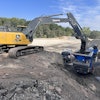



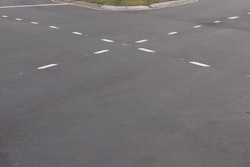
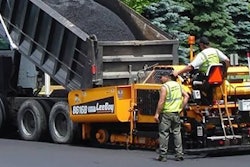

![[VIDEO] LeeBoy Introduces Four New Pavers at CONEXPO-CON/AGG 2017](https://img.forconstructionpros.com/files/base/acbm/fcp/image/2017/03/default.58c015e0a4643.png?auto=format%2Ccompress&fit=crop&h=167&q=70&w=250)
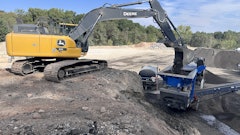




![Lee Boy Facility 2025 17 Use[16]](https://img.forconstructionpros.com/mindful/acbm/workspaces/default/uploads/2025/09/leeboy-facility-2025-17-use16.AbONDzEzbV.jpg?ar=16%3A9&auto=format%2Ccompress&fit=crop&h=135&q=70&w=240)



